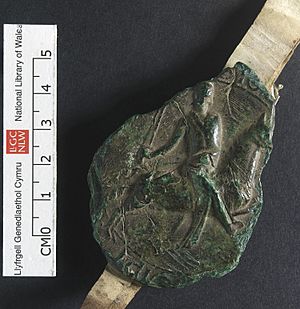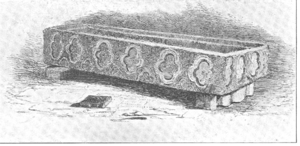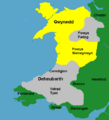Llywelyn ab Iorwerth facts for kids
Quick facts for kids Llywelyn ab Iorwerth |
|||||
|---|---|---|---|---|---|
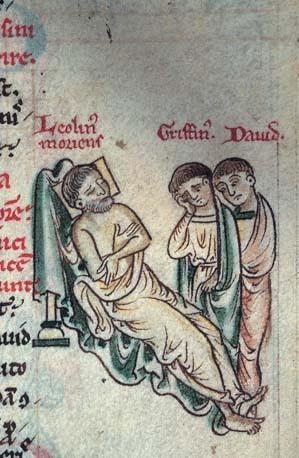
|
|||||
| Prince of Wales | |||||
| Reign | 1228–1240 | ||||
| Predecessor | Rhys ap Gruffydd | ||||
| Successor | Dafydd ap Llywelyn | ||||
| Prince of Gwynedd | |||||
| Reign | 1195–1240 | ||||
| Predecessor | Dafydd ab Owain Gwynedd | ||||
| Successor | Dafydd ap Llywelyn | ||||
| Prince of Powys Wenwynwyn | |||||
| Reign | 1216–1240 | ||||
| Predecessor | Gwenwynwyn | ||||
| Successor | Gruffydd ap Gwenwynwyn | ||||
| Born | c. 1173 Dolwyddelan, Kingdom of Gwynedd |
||||
| Died | 11 April 1240 (aged 66–67) Cistercian Aberconwy Abbey, Principality of Wales |
||||
| Burial | Aberconwy Abbey, Wales | ||||
| Spouse | Joan, Lady of Wales | ||||
| Issue |
|
||||
|
|||||
| Welsh | Llywelyn Fawr | ||||
| House | Aberffraw | ||||
| Father | Iorwerth Drwyndwn | ||||
| Mother | Marared ferch Madog | ||||
Llywelyn ab Iorwerth (around 1173 – 11 April 1240) was a very important Welsh ruler in the Middle Ages. He is also known as Llywelyn the Great. He became the prince of Gwynedd in 1195. Later, in 1216, he also became prince of Powys Wenwynwyn.
Llywelyn was a strong leader. He used both fighting and talking to control Wales for 45 years. He made Wales a powerful place during his time.
When Llywelyn was a child, his uncles ruled Gwynedd. They had divided the kingdom after his grandfather, Owain Gwynedd, died in 1170. Llywelyn believed he was the rightful ruler. He started working to gain power at a young age.
By 1200, Llywelyn was the sole ruler of Gwynedd. He made a peace agreement with King John of England that same year. Their relationship stayed good for about ten years. Llywelyn even married King John's daughter, Joan, in 1205.
In 1208, King John arrested Gwenwynwyn of Powys. Llywelyn used this chance to take over southern Powys. But in 1210, things got worse between Llywelyn and King John. John invaded Gwynedd in 1211. Llywelyn had to give up lands east of the River Conwy. However, he got them back the next year by working with other Welsh princes.
He also joined forces with the barons who made King John sign the Magna Carta in 1215. By 1216, Llywelyn was the most powerful leader in Wales. He held a meeting at Aberdyfi to divide lands among the other princes.
After King John died, Llywelyn made a treaty with the new king, Henry III, in 1218. For the next 15 years, Llywelyn often fought with powerful lords near the Welsh border. He also made alliances with some of them. His military career ended in 1234 with the Peace of Middle. This truce was extended every year until he died. Llywelyn kept his strong position in Wales until his death in 1240. His son, Dafydd ap Llywelyn, took over after him.
Llywelyn's Early Life and Family
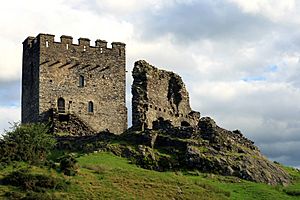
Llywelyn was born around 1173. His father was Iorwerth ab Owain. His grandfather was Owain Gwynedd, who ruled Gwynedd until 1170. Llywelyn came from a very old and important Welsh royal family. He was likely born in Dolwyddelan, a royal area. He might have been born in an older castle near the one he later built himself.
Not much is known about his father, Iorwerth Drwyndwn. Iorwerth died when Llywelyn was a baby. There is a story that Iorwerth had a disability. This might have stopped him from becoming ruler.
After Owain Gwynedd died, Gwynedd was split between two of Llywelyn's uncles. They were Dafydd ab Owain and Rhodri ab Owain. The church did not see their parents' marriage as proper. So, Llywelyn was seen as the true heir to the throne of Gwynedd.
Llywelyn's mother was Marared. She was the daughter of Madog ap Maredudd, a prince from Powys. After Llywelyn's father died, his mother may have married into an English family. Llywelyn might have spent some of his childhood in England.
How Llywelyn Gained Power (1188–1199)
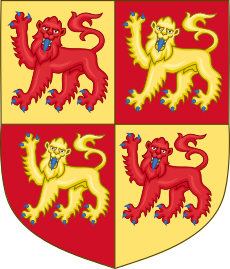
In 1194, Llywelyn worked with his cousins to defeat his uncle Dafydd. This happened at the Battle of Aberconwy. After this, Llywelyn ruled the lands east of the River Conwy.
His other uncle, Rhodri, died in 1195. His cousins took over Rhodri's lands. In 1197, Llywelyn captured Dafydd and put him in prison. He was released a year later and went to England.
Wales was divided into areas ruled by Welsh princes and areas ruled by English lords. After Rhys ap Gruffydd died in 1197, the southern Welsh kingdom became weaker. Gwenwynwyn, prince of Powys, tried to become the main Welsh leader. But his army was defeated in 1198. This gave Llywelyn a chance to become the new leader of the Welsh.
In 1199, Llywelyn captured the important Mold castle. He began to call himself "prince of the whole of North Wales."
Llywelyn's Rule as Prince of Gwynedd
Becoming Stronger (1200–1209)
In 1200, Llywelyn's cousin Gruffudd died. This made Llywelyn the undisputed ruler of Gwynedd. In 1201, he took more land from another cousin. In July 1201, Llywelyn signed a treaty with King John of England. This was the first written agreement between an English king and a Welsh ruler. Llywelyn promised to be loyal to the king. In return, he kept his lands and Welsh law could be used for some land cases.
In 1202, Llywelyn planned to attack Gwenwynwyn of Powys. But church leaders helped them make peace. Llywelyn punished one lord who did not join his army by taking away his lands.
Llywelyn made his position stronger in 1205 by marrying Joan. She was the daughter of King John.
In 1208, King John arrested Gwenwynwyn of Powys. Llywelyn used this chance to take over southern Powys and northern Ceredigion. He also rebuilt Aberystwyth Castle. In 1209, he even joined King John on a military trip against the King of Scotland.
Challenges and Comebacks (1210–1217)
In 1210, Llywelyn's relationship with King John got worse. King John's army invaded Gwynedd. Llywelyn destroyed his own Deganwy castle and moved west. King John invaded again in 1211 with a bigger army. They burned Bangor. Llywelyn had to make peace. He sent his wife Joan to talk to her father, King John. Joan convinced her father not to take all of Llywelyn's lands. But Llywelyn lost all his lands east of the River Conwy. He also had to give King John many animals and hostages, including his son Gruffydd.

This was a difficult time for Llywelyn. But he quickly regained his power. Other Welsh princes who had helped King John soon became unhappy with him. Llywelyn formed an alliance with Gwenwynwyn of Powys and other Welsh rulers. They rose up against King John. They even had the support of the Pope. The Pope released Llywelyn and his allies from their loyalty oaths to King John. Llywelyn got back almost all of Gwynedd within two months in 1212.
King John planned another invasion in 1212. But he received warnings from his daughter Joan and the King of Scotland. They told him his own lords might turn against him. So, the invasion was stopped. In 1213, Llywelyn captured the castles of Deganwy and Rhuddlan.
Llywelyn then allied with the King of France. He also joined the barons who were rebelling against King John. Llywelyn captured Shrewsbury in 1215. When King John was forced to sign the Magna Carta, Llywelyn gained good terms for Wales. His son Gruffydd, who had been a hostage, was released.
Llywelyn was now the clear leader of the independent Welsh princes. In December 1215, he led an army to capture several castles in South Wales. He also made sure Welshmen were chosen as bishops for two important church areas.
In 1216, Llywelyn held a meeting at Aberdyfi. There, the other Welsh princes promised their loyalty to him. Gwenwynwyn of Powys changed sides again and joined King John. Llywelyn led a campaign against him and drove him out of southern Powys. Both Gwenwynwyn and King John died that year. King John left a young son, Henry III, as the new king.
In 1217, one of Llywelyn's allies, Reginald de Braose, switched to the English side. Llywelyn invaded his lands. He took control of towns like Swansea and Haverfordwest.
Peace and Border Fights (1218–1229)
After King John's death, Llywelyn signed the Treaty of Worcester with King Henry III in 1218. This treaty confirmed that Llywelyn could keep all the lands he had recently won. From then on, Llywelyn was the most powerful person in Wales. He still had some fights with English lords near the border and sometimes with the king.
Llywelyn made alliances by marrying his daughters into important English families. His daughter Gwladus Ddu was married to Reginald de Braose. Another daughter, Marared, married Reginald's nephew. His daughter Elen married the Earl of Chester's nephew. After Reginald de Braose died, Gwladus Ddu married a powerful lord from the Mortimer family.
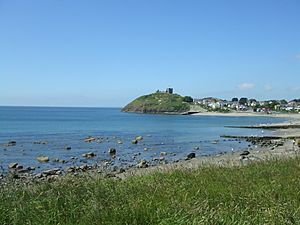
Llywelyn was careful not to start unnecessary fights. For example, in 1220, he made a Welsh prince return lands to their English owners. He also built many strong stone castles to protect his borders. These were some of the first advanced stone castles in Wales. His castles at Criccieth, Deganwy, Dolbadarn, Dolwyddelan, and Castell y Bere are great examples. Llywelyn also helped develop towns in Gwynedd for trade.
In 1220, fighting broke out with William Marshal, a powerful English earl. Llywelyn destroyed castles and threatened Pembroke Castle. He agreed to stop the attack for a payment. In 1223, Llywelyn captured two castles in England. But the Marshalls, with royal army support, took back castles in South Wales. Llywelyn made an agreement with the king. He gave up his English conquests, and his allies got their lands back.
In 1228, Llywelyn fought against Hubert de Burgh, a very powerful English official. Hubert was building a new castle near Llywelyn's lands. King Henry helped Hubert. But Llywelyn forced the royal army to retreat. Henry agreed to destroy the half-built castle if Llywelyn paid £2,000. Llywelyn got this money by demanding it as ransom for William de Braose, whom he had captured.
Later Years and Peace (1231–1240)
In 1231, there was more fighting. Llywelyn was worried about Hubert de Burgh's growing power. Some of Llywelyn's men were killed by English soldiers. Llywelyn responded by burning towns and capturing castles in South Wales. He also recaptured Cardigan Castle. King Henry invaded Wales but could not go very far.
In 1232, Hubert de Burgh lost his job and was imprisoned. In 1233, Llywelyn allied with Richard Marshal, another powerful English earl. In January 1234, they captured Shrewsbury. Richard was killed in Ireland in April. But the king agreed to make peace. The Peace of Middle was signed on June 21. It set up a two-year truce with Llywelyn. Llywelyn was allowed to keep Cardigan and Builth. This truce was renewed every year for the rest of Llywelyn's life.
Llywelyn's Death and What Happened Next
Planning for the Next Ruler
In his later years, Llywelyn worked hard to make sure his only legitimate son, Dafydd, would become the next ruler of Gwynedd. He changed Welsh law to favor children born in a church-approved marriage. This was different from old Welsh customs, where the oldest son was the heir, no matter if his parents were married or not. Llywelyn wanted Dafydd to have a strong position with the English and the Church.
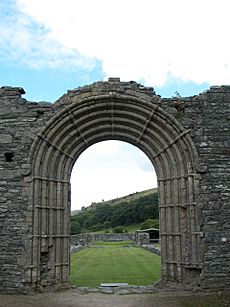
In 1220, Llywelyn convinced King Henry's government to accept Dafydd as his heir. In 1222, he asked the Pope to confirm Dafydd's succession. The Pope agreed, saying he was happy Llywelyn was changing the old custom. In 1226, Llywelyn persuaded the Pope to declare his wife Joan, Dafydd's mother, as a legitimate daughter of King John. This also helped strengthen Dafydd's claim. In 1229, the English king accepted Dafydd's promise of loyalty for the lands he would inherit.
In 1238, Llywelyn held a big meeting at Strata Florida Abbey. There, the other Welsh princes swore loyalty to Dafydd. Llywelyn also arranged for Dafydd to marry Isabella de Braose. She was the daughter of William de Braose, who had no sons. Llywelyn hoped her family's lands in South Wales would pass to Dafydd's children.
Dafydd's older half-brother, Gruffydd, was not the main heir. Llywelyn gave him some lands to rule. But Gruffydd was said to be a harsh ruler. So, Llywelyn took those lands back in 1221. In 1228, Llywelyn imprisoned Gruffydd. He was released in 1234 and given a different area to rule. This time, he did better.
Llywelyn's Death and the New Ruler
Joan, Llywelyn's wife, died in 1237. Llywelyn seems to have had a stroke that same year. After this, his son Dafydd took a bigger role in ruling. Dafydd took lands from his half-brother Gruffydd. He also captured Gruffydd and his oldest son and held them in Criccieth Castle.
Llywelyn died on April 11, 1240. He died at the Cistercian abbey of Aberconwy, which he had founded. He was buried there. His stone coffin can now be seen in St Grwst's Church, Llanrwst.
Dafydd became the prince of Gwynedd after Llywelyn. But King Henry III did not want Dafydd to have as much power as his father had in the rest of Wales. Dafydd had to agree to a treaty that greatly limited his power. He also had to hand his half-brother Gruffydd over to the king. The king could then use Gruffydd against Dafydd. Gruffydd was killed in 1244 trying to escape from the Tower of London. This cleared the way for Dafydd. But Dafydd himself died in 1246. His nephew, Gruffydd's son Llywelyn ap Gruffudd, eventually became the next ruler.
Llywelyn's Place in History
Llywelyn was a very important ruler in Wales for over 40 years. He is one of only two Welsh rulers to be called "the Great." The other was his ancestor, Rhodri the Great. An English writer named Matthew Paris was one of the first to call Llywelyn "the Great."
Llywelyn's Children
Llywelyn married Joan, the daughter of King John of England, in 1205. They had several children. Llywelyn also had children with other women.
- Children by Joan
- Dafydd ap Llywelyn (born around 1212, died 1246)
- Gwladus Ddu (born 1206, died 1251), who married two important lords.
- Elen ferch Llywelyn (Helen or Ellen) (born 1207, died 1253), who also married two important lords.
- Susanna ferch Llywelyn (died after November 1228)
- Marared ferch Llywelyn (died after 1268), who married two important lords.
- Elen the Younger ferch Llywelyn (born before 1230, died after 1295). Her daughter, Isabella of Mar, married Robert, the Bruce, King of Scots.
- Children by Tangwystl Goch (died around 1198)
- Gruffydd ap Llywelyn (born around 1196, died 1244). He was Llywelyn's oldest son. His sons included Llywelyn ap Gruffudd, who became a powerful ruler in Wales, and Dafydd ap Gruffydd.
- Children whose mother is not certain
- Angharad ferch Llywelyn (born around 1212, died 1256)
- Tegwared y Baiswen ap Llywelyn (born around 1215)
Family Tree
| Llywelyn | |||||||||||||||||||||||||||||||||||||
| Gruffydd ap Llywelyn 1200–1244 |
Dafydd ap Llywelyn 1212–1240–1246 |
||||||||||||||||||||||||||||||||||||
| Owain Goch ap Gruffydd d. 1282 |
Llywelyn ap Gruffudd 1223–1246–1282 |
Dafydd ap Gruffydd 1238–1282–1283 |
Rhodri ap Gruffudd 1230–1315 |
||||||||||||||||||||||||||||||||||
| Gwenllian of Wales 1282–1337 |
Llywelyn ap Dafydd 1267–1283–1287 |
Owain ap Dafydd 1275–1287–1325 |
Tomas ap Rhodri 1300–1325–1363 |
||||||||||||||||||||||||||||||||||
| Owain Lawgoch 1330–1378 |
|||||||||||||||||||||||||||||||||||||
Llywelyn in Books and Stories
Many Welsh poems from Llywelyn's time still exist. They were written by poets who praised him.
Llywelyn is also a character in modern Welsh plays. The play Siwan (1956) is about William de Braose and Llywelyn's wife Joan. Another famous Welsh play is Llywelyn Fawr by Thomas Parry.
Llywelyn is also a main character in several English novels:
- Raymond Foxall's Song for a Prince: The Story of Llywelyn the Great (1959) covers part of his reign.
- Sharon Kay Penman's Here Be Dragons (1985) focuses on Llywelyn's marriage to Joan. She also wrote Dragon's Lair (2003) about his younger years.
- Edith Pargeter's "The Heaven Tree Trilogy" (1960–63) also features Llywelyn and his family.
- Gaius Demetrius's Ascent of an Eagle (2006) tells the story of the early part of Llywelyn's rule.
The famous story of the loyal dog Gelert, owned by Llywelyn, is a legend. In the story, Llywelyn mistakenly kills his dog. "Gelert's grave" is a popular place to visit in Beddgelert. But the story is thought to be a folktale, not a true event.
Images for kids
See also
 In Spanish: Llywelyn el Grande para niños
In Spanish: Llywelyn el Grande para niños


